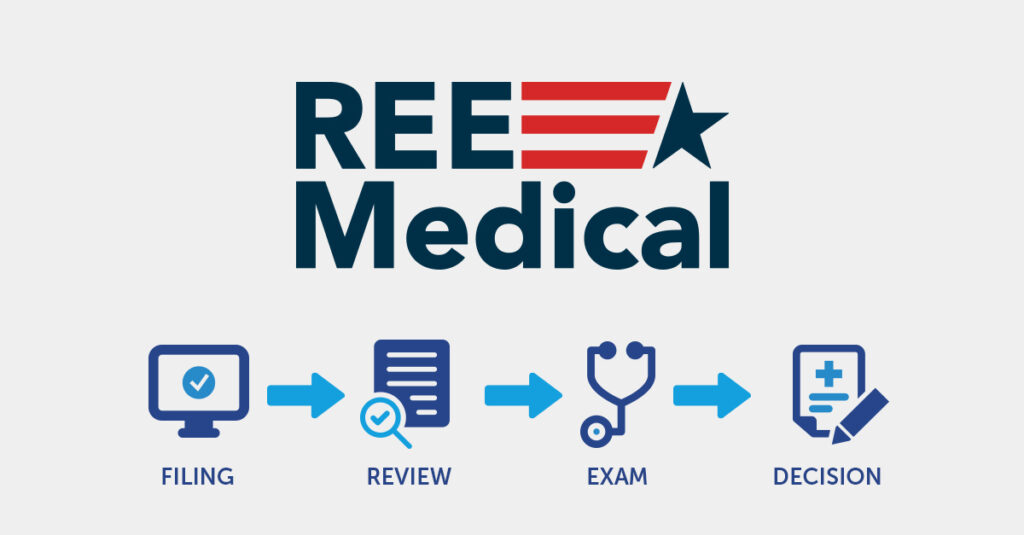Anxiety disorders can have a profound effect on a veteran’s ability to work, sustain relationships, and manage everyday responsibilities. The Department of Veterans Affairs (VA) recognizes several types of anxiety disorders as potentially service-connected conditions and provides disability evaluations based on the severity of symptoms and functional impact.
This guide explains how the VA assigns ratings, which symptoms are considered under 38 C.F.R. § 4.130, and what types of medical documentation are typically reviewed during the evaluation process.
TL;DR: Your Key Takeaways
- VA Rating System: The Department of Veterans Affairs (VA) rates anxiety under the General Rating Formula for Mental Disorders (38 C.F.R. § 4.130). Ratings from 0–100% reflect the level of occupational and social impairment, not just the diagnosis.
- Service Connection: The VA reviews whether evidence shows that anxiety began during service, was aggravated by it, or is secondary to another service-connected condition.
- DBQs: The Mental Disorders (Other Than PTSD) DBQ gives providers a standardized way to document symptoms, treatment history, and functional impact for VA review.
- C&P Exams: A Compensation & Pension (C&P) exam may be scheduled to assess current symptoms (like anxiety and depression) and how they affect daily functioning.
- Evidence Reviewed: The VA considers medical opinions, DBQs, nexus letters, and lay statements to understand the full impact of a veteran’s mental health.
- Decision Reviews: Under the Appeals Modernization Act (AMA), veterans can request a Supplemental Claim, Higher-Level Review, or Board Appeal if they disagree with a decision.
- REE Medical’s Role: REE Medical connects veterans with independent, licensed clinicians for accurate and objective DBQs and evaluations. REE Medical does not prepare, present, or submit VA claims or provide legal services.
What’s the VA Anxiety Rating and How’s It Decided?

The Department of Veterans Affairs (VA) assigns percentage ratings from 0 to 100 percent for anxiety disorders under the Schedule for Rating Disabilities, using the General Rating Formula for Mental Disorders (38 C.F.R. § 4.130). Each percentage reflects the degree of occupational and social impairment caused by documented symptoms—not the diagnosis alone.
This evaluation framework considers how features such as panic attacks, concentration difficulties, or social withdrawal affect overall reliability and functioning. The percentage assigned corresponds to the level of impairment recognized by the VA.
How the VA Rates Anxiety Disorders
- Anxiety and related conditions (e.g., Generalized Anxiety Disorder, Diagnostic Code 9400) are evaluated as follows:
- 0% – A mental condition is diagnosed, but symptoms are not severe enough to interfere with functioning or require continuous medication.
- 10% – Mild or transient symptoms cause occasional decreases in work efficiency or intermittent inability to perform occupational tasks.
- 30% – Occupational and social impairment with occasional decreases in work efficiency and intermittent inability to perform tasks (e.g., chronic sleep disturbance, mild anxiety, infrequent panic attacks).
- 50% – Reduced reliability and productivity (e.g., frequent panic attacks, impaired judgment, difficulty maintaining work or social relationships).
- 70% – Deficiencies in most areas—work, school, family relations, judgment, or mood—with symptoms such as near-continuous anxiety, difficulty adapting to stress, or neglect of personal hygiene.
- 100% – Total occupational and social impairment (e.g., persistent danger to self or others, disorientation, inability to perform activities of daily living).
Each evaluation level corresponds to specific symptoms and the overall degree of functional limitation documented in medical evidence reviewed by the VA.
What Symptoms Does the VA Look For?
When assessing anxiety disorders, the Department of Veterans Affairs (VA) reviews medical and behavioral evidence that reflects how symptoms affect daily functioning and occupational performance. Commonly documented symptoms include:
- Excessive worry or persistent nervousness that interferes with concentration or work performance.
- Avoidance of people, crowds, or social situations.
- Difficulty remembering details or maintaining focus.
- Sleep disturbance or frequent panic attacks.
- Severe distress, which in some cases may include thoughts of self-harm.
The VA evaluates these symptoms through clinical assessments, Disability Benefits Questionnaires (DBQs), and other medical records to determine how significantly the condition impacts occupational and social functioning.
How PTSD Affects Your Anxiety Rating
Post-Traumatic Stress Disorder (PTSD) and anxiety disorders often appear together, and their overlapping symptoms can affect how the Department of Veterans Affairs (VA) evaluates mental-health conditions.
When both conditions stem from the same traumatic experience, the VA typically assigns a single evaluation that reflects the combined level of occupational and social impairment, rather than separate ratings for each diagnosis.
Symptoms such as hypervigilance, panic attacks, and sleep disturbance are assessed as part of the overall functional impact documented in medical evidence and provider evaluations.
Connecting Your Anxiety to Military Service

The VA determines whether anxiety disorders are service-connected by reviewing medical evidence and service records that show the condition began during, or was aggravated by, military service—or developed as secondary to another service-connected disability.
Establishing service connection is required before the VA can assign a disability evaluation under 38 C.F.R. § 3.303. Even when symptoms are severe, compensation is only available once that connection has been verified.
Why Service Connection is a Must Understanding Service Connection for Anxiety
The VA determines whether anxiety disorders are service-connected by reviewing medical evidence and service records that show the condition began during, or was aggravated by, military service—or developed as secondary to another service-connected disability.
Establishing service connection is required before the VA can assign a disability evaluation under 38 C.F.R. § 3.303. Even when symptoms are severe, compensation is only available once that connection has been verified.
How Military Service Can Lead to Anxiety
Military service can expose individuals to experiences that contribute to the development of anxiety-related conditions. Factors such as extended deployments, high-stress environments, and separation from family have been associated with Generalized Anxiety Disorder (GAD), panic disorder, and social anxiety.
Clinical documentation describing how stress exposure or operational demands affected a veteran’s mental health helps medical providers and evaluators understand the onset and progression of anxiety symptoms within a service context.
Can Military Sexual Trauma (MST) or Combat Exposure Be Associated with Anxiety Disorders?
Military Sexual Trauma (MST) and combat exposure are recognized by the Department of Veterans Affairs (VA) as potential sources of anxiety and other mental-health conditions. When evaluating these cases, the VA reviews medical opinions, service records, and credible supporting evidence to determine whether symptoms are linked to experiences that occurred during military service.
If a clinician confirms that an anxiety disorder is related to documented MST or combat stressors, that opinion becomes part of the medical evidence the VA considers when assigning an evaluation.
The Role of the Disability Benefits Questionnaire (DBQ)

A well-filled-out DBQ is like the foundation of your anxiety claim. It translates what your doctor observes into the specific language the VA uses to rate disabilities.
What’s a DBQ and How Does It Show Your Anxiety?
The Disability Benefits Questionnaire (DBQ) provides a standardized format for documenting medical findings. For anxiety and related conditions, the Mental Disorders (Other Than PTSD) DBQ includes sections for:
- Symptom frequency and severity.
- Occupational and social impact.
- Treatment history and medication use.
This structured information helps the VA evaluate mental-health conditions consistently under 38 C.F.R. § 4.130.
What Happens During an Anxiety DBQ Evaluation?
During a DBQ assessment, a licensed medical provider reviews clinical history, treatment records, and observed symptoms to complete the standardized form.
The provider’s objective documentation helps ensure that information about anxiety—such as panic attacks, concentration issues, or sleep disturbance—is clearly recorded for VA review.
REE Medical coordinates independent, licensed clinicians who complete accurate, objective DBQs. REE Medical does not prepare, present, or submit VA disability claims and does not offer legal or representational services.
Why Accurate DBQ Completion Matters
A Disability Benefits Questionnaire (DBQ) is most effective when it is complete and specific. Thorough documentation allows Department of Veterans Affairs (VA) evaluators to clearly understand the nature and severity of a condition.
If sections are left incomplete or descriptions are too general, it may be difficult for the VA to assess how symptoms—such as panic attacks, sleep disturbance, or social withdrawal—affect daily functioning. Accurate, detailed medical reporting ensures that the clinical picture is fully represented during the VA’s review process.
What to Expect During a VA C&P Exam for Anxiety

The VA may schedule a Compensation & Pension (C&P) exam to document the current severity of a veteran’s anxiety. This evaluation helps ensure the VA has up-to-date medical information when determining a rating under 38 C.F.R. § 4.130.
What Happens During the Anxiety C&P Exam?
The Compensation & Pension (C&P) exam is a medical evaluation the Department of Veterans Affairs (VA) may schedule to document the current severity of a veteran’s anxiety or related mental-health condition. During this appointment, a VA-appointed clinician reviews the veteran’s records, observes current symptoms, and may ask questions about mood, concentration, or social and occupational functioning.
The examiner’s findings are used to determine the level of occupational and social impairment under the General Rating Formula for Mental Disorders (38 C.F.R. § 4.130).
Under 38 C.F.R. § 3.303, these elements together help establish whether a current diagnosis is related to military service.
What the C&P Exam Typically Includes
A C&P evaluation for anxiety generally involves:
- Discussion of symptom frequency, duration, and impact on daily life.
- Review of treatment history and medical documentation.
- Observation of behavioral and emotional presentation during the appointment.
- Completion of brief clinical assessments that measure memory, focus, or mood.
These observations help ensure that the VA has current, objective medical information to support an accurate evaluation.
REE Medical is not affiliated with the Department of Veterans Affairs and does not prepare or participate in C&P exams. However, our independent medical evaluations help ensure a veteran’s health documentation is thorough, objective, and ready for VA review.
What Veterans Can Expect
Because the C&P exam is part of the VA’s evidentiary process, each evaluation focuses on documenting symptoms rather than providing treatment. Veterans who want to understand the process in greater depth can review official guidance on VA.gov or seek assistance from an accredited Veterans Service Organization (VSO).
Evidence Considered in VA Anxiety Evaluation

In addition to Disability Benefits Questionnaires (DBQs) and Compensation and Pension (C&P) exams, the Department of Veterans Affairs (VA) may review other forms of documentation when evaluating anxiety disorders. These can include treatment records, employment history, clinical notes from licensed professionals, and statements from family members or colleagues describing observable changes in behavior and functioning.
This collective medical and observational evidence helps the VA determine the level of occupational and social impairment consistent with its rating criteria.
Understanding the 100% Rating for Total Impairment
A 100% evaluation for anxiety reflects total occupational and social impairment as defined by the General Rating Formula for Mental Disorders (38 C.F.R. § 4.130). Clinical findings such as persistent danger to self or others, disorientation, or inability to perform daily activities are examples of factors considered at this level.
Supporting medical documentation—such as DBQs, specialist reports, and mental-health evaluations—provides the VA with a comprehensive record of symptom severity.
Decision Reviews and Rating Updates
Veterans who disagree with a decision or whose condition has changed may pursue a review or rating update through the VA decision review process established by the Appeals Modernization Act (AMA).
The VA outlines three primary review options on VA.gov:
- Supplemental Claim: For submitting new and relevant evidence.
- Higher-Level Review: A new evaluation of the same record by a senior VA adjudicator.
- Board of Veterans’ Appeals (BVA): A formal review that may include a hearing.
Official information about each pathway and eligibility requirements is available directly through the VA.
REE Medical’s Role in Evidence Coordination

REE Medical coordinates with independent, licensed medical professionals who prepare DBQs and clinical evaluations designed to accurately document a veteran’s medical condition. These documents can provide the VA with clear, standardized medical evidence for review.
REE Medical does not prepare, present, or submit VA disability claims, and does not offer legal or representational services.
Common Questions Veterans Ask About VA Anxiety Claims
Here are answers to some of the most frequent questions about how the Department of Veterans Affairs (VA) evaluates anxiety disorders for disability purposes.
What Information Does the VA Review for an Anxiety Evaluation?
The VA generally requires VA Form 21-526EZ to initiate a disability claim. When reviewing an anxiety-related claim, the VA considers medical records, diagnostic information, and Disability Benefits Questionnaires (DBQs) completed by licensed providers.
Once service connection is verified, the VA may schedule a Compensation and Pension (C&P) exam and determine a rating percentage based on the evidence of occupational and social impairment.
Can Anxiety Be Service Connected Without Combat?
Yes. The VA recognizes that anxiety disorders can result from a wide range of service-related experiences, not just combat.
Stressful training, in-service injuries, or military sexual trauma (MST) may be considered potential causes if supported by credible evidence and a medical opinion linking the condition to military service.
The examiner’s report becomes part of the evidence the Department of Veterans Affairs (VA) uses when determining evaluation levels under Diagnostic Code 7101 (38 C.F.R. § 4.104).
Veterans seeking information about the C&P process can refer to official VA.gov resources or contact an accredited Veterans Service Organization (VSO) for additional assistance.
How Long Does It Take to Get a VA Rating for Anxiety?
Timelines vary depending on case complexity, available evidence, and scheduling for exams. Some claims are resolved within several months, while others take longer if additional documentation or review is required. The VA provides estimated processing times and status updates on VA.gov.
What Are the Most Important Details Veterans Miss in Anxiety Claims?
Medical documentation that highlights functional impact—such as how anxiety affects employment, relationships, or daily responsibilities—is often essential in determining rating levels.
Comprehensive DBQs, nexus letters, and lay statements can provide context that helps the VA accurately understand the scope of a veteran’s symptoms.
Frequently Asked Questions
What Documentation Is Required to Support a VA Anxiety Claim?
The VA generally reviews medical records that document diagnosis and treatment history, clinical notes describing symptom severity and functional impact, relevant service records/exposure history, and lay statements from the Veteran or others who can describe observable symptoms. A Disability Benefits Questionnaire (DBQ) completed by a qualified medical professional can provide structured clinical findings the VA may consider during adjudication.
Note: REE Medical coordinates independent, licensed medical professionals who prepare neutral, thorough DBQs; REE does not prepare, present, or submit claims.
What Should Veterans Do If Their Anxiety Claim Is Denied?
Under the Appeals Modernization Act (AMA), VA offers three decision review options:
- Supplemental Claim (consideration of new and relevant evidence),
- Higher-Level Review (a de novo review by a senior adjudicator using the existing record), and
- Board of Veterans’ Appeals review (including Board docket options and, where applicable, hearings). Veterans seeking assistance with any review option can contact an accredited Veterans Service Organization (VSO), attorney, or claims agent listed by VA.
Can Anxiety Disorders Be Rated Alongside Other Mental Health Conditions?
VA generally assigns a single evaluation for all service-connected mental health conditions together, based on the overall level of occupational and social impairment described in 38 C.F.R. § 4.130—rather than separate ratings for each diagnosis. The combined presentation of symptoms and functional impact drives the evaluation.
What Are the Benefits of Seeking Professional Help for VA Claims?
Veterans often need both strong medical documentation and accredited representation to navigate the VA process effectively. While accredited VSOs, attorneys, and agents can assist with formal representation before the VA, REE Medical plays a different but equally important role, helping veterans access clear, evidence-based medical evaluations that give the VA a complete picture of their health. REE Medical does not prepare or submit claims, but our work ensures your documentation is accurate, objective, and ready for VA review.
How Does the VA Evaluate the Impact of Anxiety on Daily Life?
Evaluations reference the General Rating Formula for Mental Disorders (38 C.F.R. § 4.130), which considers both symptomatology (e.g., panic, sleep disturbance, concentration problems) and the resulting level of occupational and social impairment (e.g., mild/transient; reduced reliability and productivity; deficiencies in most areas; or total impairment). Evidence in the record—such as clinician notes and standardized assessments—helps VA determine which impairment level best reflects the Veteran’s current presentation.
Get a Free Consultation for Your Anxiety VA Claim
Conclusion
If you’re a veteran seeking VA disability benefits for anxiety, understanding how the VA rates conditions and documenting your symptoms thoroughly can make a huge difference. By using expert support and gathering strong evidence, you can navigate the claims process more easily.
Taking the next step to secure the benefits you’ve earned is important. Reach out for a free consultation today to learn how you can maximize your VA rating and improve your quality of life.
Disclosure
DISCLAIMER: REE Medical, LLC is not a Veterans Service Organization (VSO) or a law firm and is not affiliated with the U.S. Veterans Administration (“VA”). Results are not guaranteed, and REE Medical, LLC makes no promises. REE Medical’s staff does not provide medical advice or legal advice, and REE Medical is not a law firm. Any information discussed, such as, but not limited to, the likely chance of an increase or service connection, estimated benefit amounts, and potential new ratings, is solely based on past client generalizations and not specific to any one patient. The doctor has the right to reject and/or refuse to complete a Veteran’s Disability Benefit Questionnaire if they feel the Veteran is not being truthful. The Veteran’s Administration is the only agency that can make a determination regarding whether or not a Veteran will receive an increase in their service-connected disabilities or make a decision on whether or not a disability will be considered service-connected. This business is not sponsored by, or affiliated with, the United States Department of Veterans Affairs, any State Department of Military and Veterans Affairs, or any other federally chartered veterans service organization.

